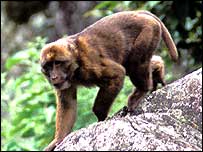
March 23, 2009

Photo: Alan Rabinowitz.
The saola (Pseudoryx nghetinhensis) was found in the former Annamite Mountains of Vietnam and Laos, in 1992 by a team of scientists from the Vietnamese Ministry of Forestry and WWF; it was the first large mammal to be discovered anywhere in the world since 1936.
What has happened since then?
At Cryptomundo, on February 14, 2009, I wrote of the new study by Paul Ehrlich and Gerardo Ceballos, who chronicled that 408 “new” species of mammals had been discovered since 1993.
You may recall some of those mammals are quite exciting.
Now, Darren Naish has summarized their new paper, in some depth, over at his Tetrapod Zoology blog. As always, Naish’s done a comprehensive job in looking at the academic facts, separating out the splitting species samplings and getting to the hard core of the good news: lots of new animals are being found.
Go there for more details, and, in the meantime, here are some images of a few of these new mammals, once again, to ponder.
Yes, there are still big animals out there to be discovered and there is more work to be done!

Bradypus pygmaeus is a pygmy three-toed sloth discovered in 2001 on a tiny Panamanian island, where it dwells in mangrove forests. Photo: Bill Haycher

Photo: W. Robichaud.
Giant muntjac Megamuntiacus vuquangensis was first discovered in 1994 in northcentral Vietnam. It has since been found all along the Truong Son (formerly “Annamite”) Mountains that straddle the border between Vietnam and Laos, and the Central Highlands, as well as in eastern Cambodia.

The grey-faced sengi, Rhynchocyon udzungwensis, a giant elephant-shrew, was first filmed in 2005, and confirmed in 2006. Photo: Francesco Rovero.

The news was announced in 2006 of the discovery of the new giant peccary, Pecari maximus, in Brazil’s River Aripuana basin.

In 2007, a new dwarf manatee (Trichechus bernhardi) was discovered in South America.

Arunachal macaque Macaca munzala was discovered in 2004, in the mountains of the Arunachal Pradesh in northeastern India. It lives at high altitudes, between 2000 meters and 3500 meters, making it one of the highest-dwelling primates. Photo: BBC.

Mirza zaza, also called the northern giant mouse lemur, was discovered in Madagascar in 2005. Photo: David Haring / Duke Lemur Center.
Continue cryptozoology into the future. Show your support today and…
Thank you.
About Loren Coleman
Loren Coleman is one of the world’s leading cryptozoologists, some say “the” leading living cryptozoologist. Certainly, he is acknowledged as the current living American researcher and writer who has most popularized cryptozoology in the late 20th and early 21st centuries.
Starting his fieldwork and investigations in 1960, after traveling and trekking extensively in pursuit of cryptozoological mysteries, Coleman began writing to share his experiences in 1969. An honorary member of Ivan T. Sanderson’s Society for the Investigation of the Unexplained in the 1970s, Coleman has been bestowed with similar honorary memberships of the North Idaho College Cryptozoology Club in 1983, and in subsequent years, that of the British Columbia Scientific Cryptozoology Club, CryptoSafari International, and other international organizations. He was also a Life Member and Benefactor of the International Society of Cryptozoology (now-defunct).
Loren Coleman’s daily blog, as a member of the Cryptomundo Team, served as an ongoing avenue of communication for the ever-growing body of cryptozoo news from 2005 through 2013. He returned as an infrequent contributor beginning Halloween week of 2015.
Coleman is the founder in 2003, and current director of the International Cryptozoology Museum in Portland, Maine.
Filed under Breaking News, Cryptotourism, CryptoZoo News, Cryptozoologists, Cryptozoology, New Species, Photos